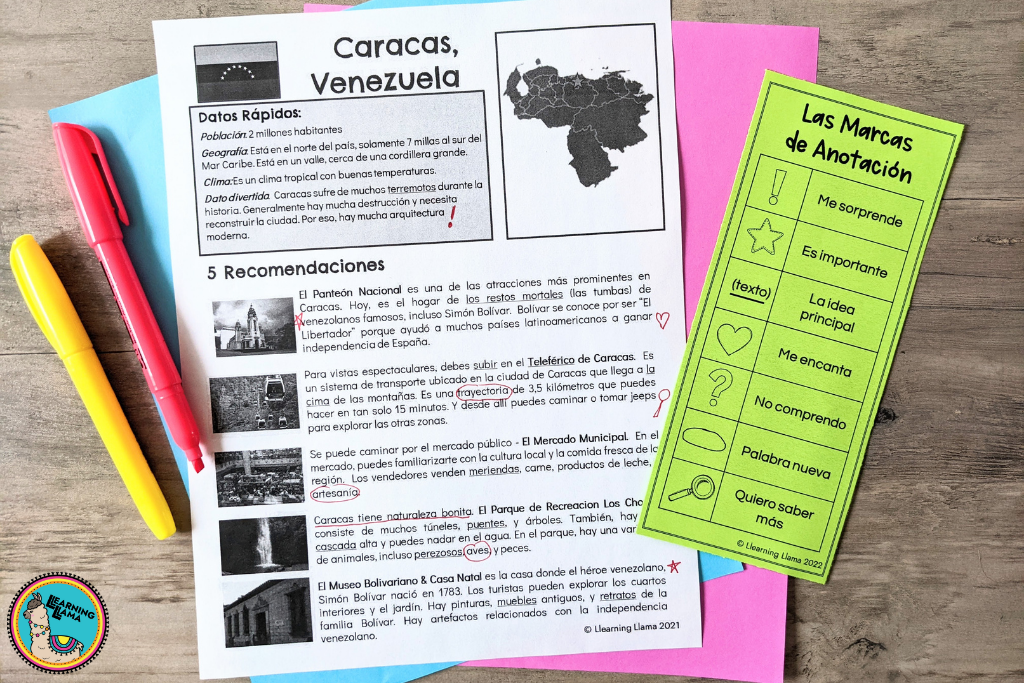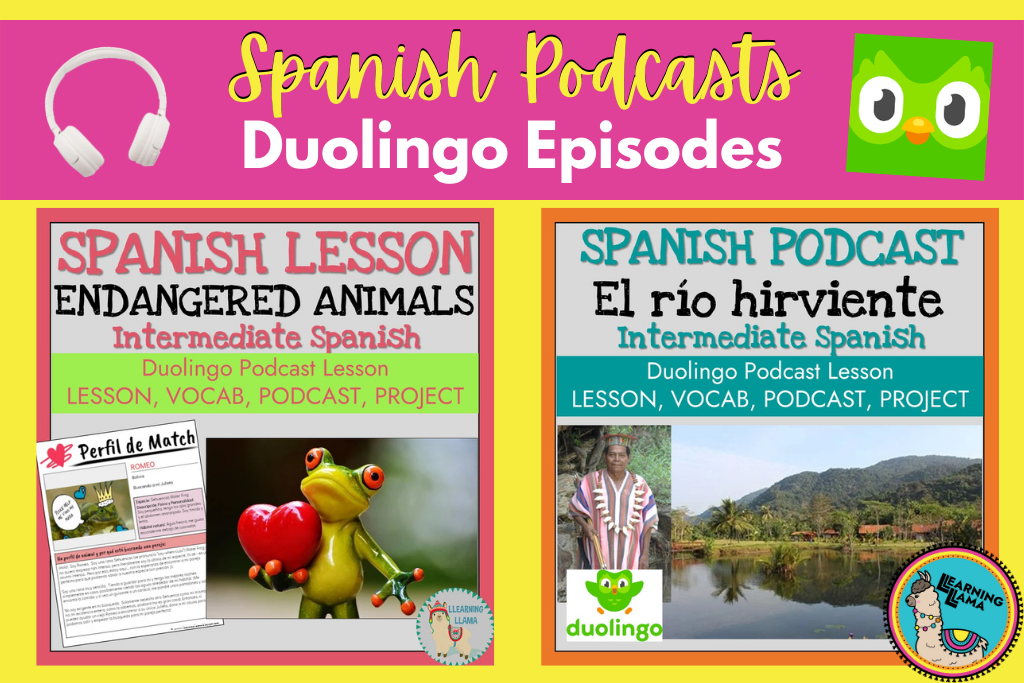This is part two of a five part blog series teaching you all about the three modes of communication: interpretive, interpersonal, and presentation. Interpretive tasks assess a student’s ability to interpret and understand a written text or audio. Finding authentic and comprehensible interpretive resources in the target language can be challenging. Keep reading to learn how to find, create, and assess interpretive tasks in Spanish class.
What is an interpretive task?
According to ACTFL, “the standards offer a new “Communicative Framework” consisting of three modes which place primary emphasis on the context and purpose of the communication.” The interpretive mode is characterized by the interpretation of written and spoken text without any active negotiation with the speaker or writer. This means that students do not get to ask questions to the speaker or writer for clarification or to interpret the meaning. ACTFL clearly notes that interpretation does not equate to comprehension.
How to find authentic interpretive resources
In order to create an interpretive task for a world language class, you must first have an authentic text. Authentic texts mean that they are made for native speakers by native speakers. With lower proficiency students that can be challenging; even for intermediate and advanced as well.
The most appropriate text will be just a little bit above your students’ current proficiency level, or as Stephen Krashen puts it, input + 1 (comprehensible input!) Here I will share with you where to find authentic interpretive resources for Spanish class.
Readings/Texts
- Pinterest has a large amount of infographics that serve as great authentic resources with quick information, especially for novice students. I have a bunch of Pinterest boards broken down by theme here. Just follow me and you’ll get my latest pins in your feed.
- Newsela is a news website for teachers and students. There is an entire Spanish library! Plus, with each article, you can change the word count to differentiate to all of your students.
- News Websites (BBC/El País/National Geographic) all have Spanish versions, but are geared towards higher proficiency levels
- Scholastic magazines come in 3 versions for all proficiency levels! With each issue I get, I am always excited to read the fun articles. They really relate to students and have current events and themes for our world language classes.
- Short stories are the perfect way to get your students’ attention! Some of my favorite websites for short stories, fairy tales, and fables are:
- Websites that we navigate websites everyday like airlines, schools, department stores, museums, etc. are the perfect example of authentic texts and provide students with real world experience in the target language. For example: LATAM airlines or the Museo Reina Sofia are great places for webquests or interpretive tasks.
When we think of “interpretive tasks,” we most often think of reading. While that is a main source of interpretive tasks, there are other types of media to explore. Try some of these interpretive resources:
Videos
You can find so many great video resources on YouTube, such as:
- El Asombroso Mundo de Zamba – a cartoon where a boy explores Hispanic culture, like visiting Frida Kahlo or the Incas!
- Spanish Playground creates conversations in Spanish for students to learn vocabulary and content in a variety of real-life settings.
- Tio Spanish might not be “authentic,” but it is a great way to introduce vocabulary and cultural aspects in a fun way for younger kids.
Videoele is another great video resource. It has 4 levels of videos with transcripts and listening activities already made for you!
Audio Clips/Podcasts
Podcasts and audio don’t come with visuals, which can make it more challenging for our students. But I have an entire blog post dedicated to how you can still use podcasts in a very comprehensible way for your students!
For a full list of resources to keep handy, make sure you get your Spanish Teacher Survival Guide FREEBIE! Fill out the form on the right of this page for your download.
How to Design Interpretive Tasks
Once you have your text(s), you now need to design an assessment or activity to assess students’ abilities to interpret it.
Interpretive Activities
- Close readings are one of the best ways for students to dig deeper into a text, searching for the meaning.
- Jigsaw reading activities are when you assign each small group of students a different reading or one section of a larger reading. They work together to interpret it, and then share out with the class their summaries and supporting details.
- Post questions or topics around the room, in the format of a gallery walk. As students read the text, they will answer the questions or provide comments on the topics by adding post-it notes next to each post around the room.
- Make the interpretive activity authentic. Put students in the role of a different “reader.” Maybe they are a detective, reading a mystery novel trying to solve a case. Or maybe they are a book reviewer giving their opinion on the text.

Creating Interpretive Assessments
There are three main areas of assessment that I always have on my interpretive tasks: main idea, supporting details, and new words in context. (Words in context should be able to be interpreted based on context clues!)
Personally, I like all the questions to be in the students’ first language, that way you see what students truly understood. If it is in Spanish, then they will most likely be copying word for word from the text without true understanding.
The best question formats for me have been short answer, true or false (students must correct the statement if it is false) and multiple choice for new words in context. When writing an interpretive test, keep all the questions in the same order that they can be found in the text.
How to Grade Interpretive Tasks
Design a rubric that assesses all the parts of your assessment. For me this is main idea, details, and new words. Your grading will go quickly, and students will see where they struggle vs. succeed. With proficiency-based rubric grading, you are validating students by showing them what they can do, rather than focusing on what they can’t do.
Make sure you give feedback to your students. Go over the assessment and discuss reading strategies for more success on the next assessment. To see examples of my Interpretive Assessments, here is my collection of Integrated Performance Assessments, each based off of an authentic text.
Bonus Tips for Developing Interpretive Skills!
Don’t expect students to write or speak during an interpretive task because then the assessment is not valid or reliable; you are strictly assessing their interpretive skills with this type of test. Don’t test other skills (unless you’re doing an IPA) because it could hinder their grade.
Use different genres of text to expose your students to a variety of topics and styles of writing: essays, stories, news articles, emails, poetry, reviews, biographies, etc.
Have more than one test method (multiple choice, fill in the blank, short answer, etc.). Give students a variety of options.
Interpretive tasks are my favorite of the three modes of communication. I hope these strategies and resources are helpful. Add your favorite authentic resources below for us to share! Check back next week for an in-depth look at presentational tasks and assessments.







5 Responses